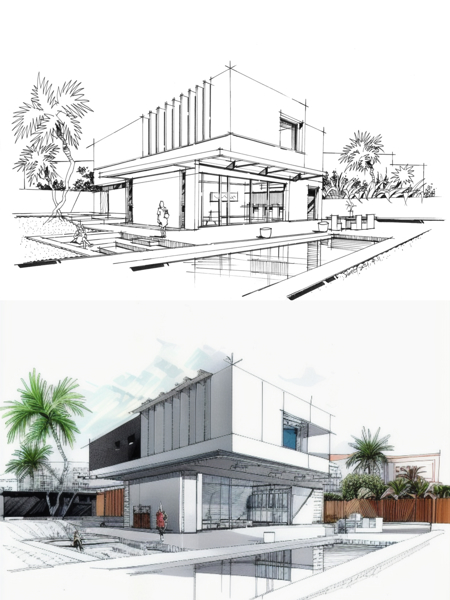Comprehending the Collaborative Process In Between Designers and Engineers in Modern Building Projects
The collective procedure in between engineers and designers is vital in contemporary construction projects, as it integrates layout intent with engineering expediency. This partnership not just affects the visual and functional aspects of a project however additionally plays a crucial function in dealing with sustainability challenges. By employing reliable communication strategies and leveraging innovative innovations, such as Building Details Modeling (BIM), teams can work much more cohesively. Nonetheless, the complexities of this partnership often existing unique challenges that can impede progression. Exploring these dynamics reveals understandings that could considerably impact project results and total sector requirements.
The Value of Collaboration
The collective synergy between engineers and engineers is important for the successful awareness of any type of building project. This partnership brings with each other distinct experience and viewpoints, making it possible for the assimilation of ingenious style with practical design services. By working together, designers and designers can make certain that a task not only satisfies visual and functional demands yet likewise follows security, sustainability, and financial restrictions.
Cooperation fosters a shared vision, facilitating the alignment of goals and expectations from the beginning. This alignment is crucial in attending to prospective obstacles and mitigating risks that can arise throughout the job lifecycle. A collective approach permits for the reliable allocation of sources, maximizing both time and expense.
The importance of cooperation includes the repetitive process of style and construction, where feedback from engineers can notify building choices, causing more feasible and lasting designs. On the other hand, designers can inspire designers to believe artistically concerning how to attain architectural stability without endangering imaginative intent. Eventually, the collaborative relationship between architects and designers is not merely valuable; it is fundamental to the development of top quality, functional, and ingenious constructed environments that meet the needs of society.
Communication Strategies and Devices
Efficient communication techniques and tools are crucial for fostering partnership in between designers and designers throughout the project lifecycle. Establishing clear networks of interaction is important to guarantee that all staff member are lined up with project goals, timelines, and responsibilities. Regular meetings, both in-person and online, provide possibilities for stakeholders to discuss progression, address worries, and make informed choices.
Making use of task administration software, such as BIM (Building Information Modeling) systems, improves partnership by making it possible for real-time sharing of design adjustments and technical specifications. These tools promote openness, permitting designers and designers to picture changes and analyze their influence on the general task.

Shared Objectives and Project Vision

Developing shared goals includes open dialogue and a comprehensive understanding of each discipline's payments. Designers commonly concentrate on layout intent, spatial relationships, and user experience, while engineers emphasize structural integrity, systems capability, and conformity with regulations (cda architects). When these viewpoints are straightened, the outcome is a cohesive task that abides by both innovative aspirations and technical feasibility
Furthermore, a distinct task vision promotes accountability amongst team participants, motivating each individual to take ownership of their duty in achieving the desired outcome. Routine check-ins and joint workshops can better enhance this commitment, permitting changes to be made as the project evolves. Eventually, a shared vision not only boosts team effort however likewise boosts the high quality of the last deliverable, causing successful project conclusion.
The Function of Modern Technology
Leveraging innovation has actually come to link be necessary in enhancing cooperation in between engineers and designers. Structure Information Modeling (BIM) stands out as a critical innovation, permitting both designers and designers to produce comprehensive 3D versions that envelop style intent and architectural stability.
In addition, cloud-based platforms enable seamless partnership, permitting project stakeholders to gain access to and update job information from anywhere. This fosters a culture of openness and accountability, as changes can be tracked and examined in real-time. Additionally, mobile applications more improve interaction, giving on-site groups with immediate access to job specs and updates.
Emerging innovations such as synthetic intelligence and device discovering are likewise beginning to play a function in anticipating analysis, aiding teams identify possible problems before they emerge. Inevitably, the function of modern technology in architecture-engineering collaboration not just enhances workflow efficiencies yet also enhances innovation, bring about more successful project end results. By welcoming these technological improvements, architects and designers can make sure a much more natural and effective collaborative process throughout the construction lifecycle.
Study in Successful Collaborations
Various situation researches illustrate the profound effect of reliable partnerships between designers and engineers on task outcomes. One remarkable example is the collaboration on the High Line in New York City City, where landscape architects, engineers, and urban organizers functioned together to change an abandoned railway right into a dynamic public park. This multidisciplinary approach not just boosted the visual quality but additionally ensured architectural safety and security and environmental sustainability.
Another exemplary case is the design and building of the Sydney Concert Hall. The partnership between designer JÃ ¸ registered nurse Utzon and architectural designer Ove Arup exemplified innovative problem-solving. Their collaboration enabled the iconic shell-like layout while addressing complex design difficulties, eventually these details leading to a timeless building masterpiece.
The Burj Khalifa in Dubai further shows the importance of collaborative initiatives. cda architects. The integration of style and engineering competence enabled the task team to achieve unmatched elevations while sticking to safety policies and aesthetic vision
These instances emphasize the value of communication, count on, and shared goals. In today's complex building setting, such collaborations are vital to navigating difficulties and delivering jobs that fulfill both functional and visionary objectives.
Verdict
To conclude, the collaboration between designers and designers is essential for the success of modern construction jobs. Efficient interaction strategies, a common task vision, and the assimilation of innovative top article technologies are critical elements that facilitate this partnership. By promoting a culture of responsibility and leveraging tools such as Building Information Modeling (BIM), teams can navigate project complexities, guaranteeing that aesthetic, useful, and sustainability goals are achieved. Inevitably, this synergy leads to innovative and effective project end results.
 Julia Stiles Then & Now!
Julia Stiles Then & Now! Barbi Benton Then & Now!
Barbi Benton Then & Now! Earvin Johnson III Then & Now!
Earvin Johnson III Then & Now! Daryl Hannah Then & Now!
Daryl Hannah Then & Now! Erika Eleniak Then & Now!
Erika Eleniak Then & Now!